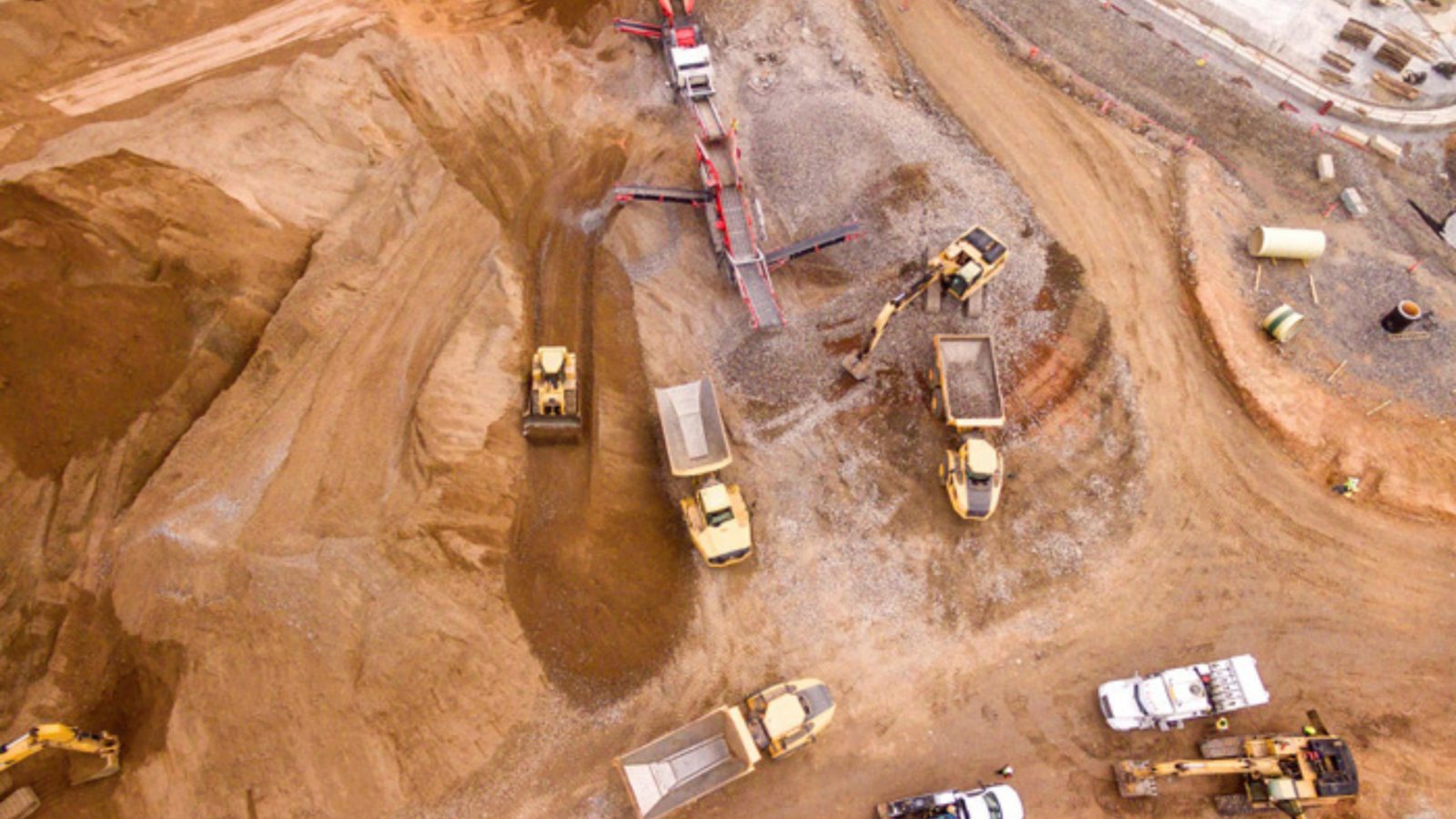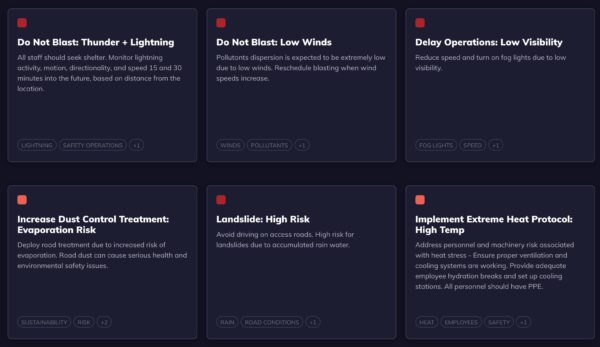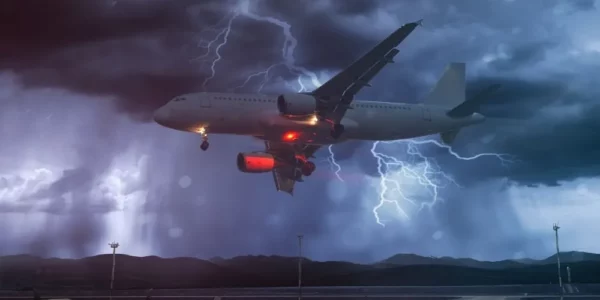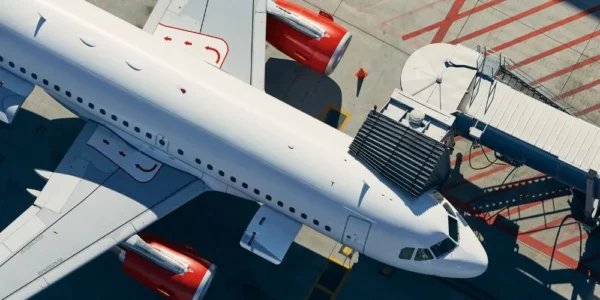As the world experiences the unfolding impacts of climate change and increasingly volatile weather, few sectors stand at the crossroads of these changes as starkly as the mining industry. An industry synonymous with exploration, extraction, and exploitation of Earth’s resources – is now grappling with severe and hazardous weather patterns and rapidly changing climate conditions, the combination of which is compounding existing challenges.
There’s an urgent need to modify and adapt operations with such intense weather impact. However, implementing these changes is not straightforward in a high-risk industry like mining. Weather intelligence and weather AI are making these changes possible and bringing mining businesses the localized, real-time weather information needed for decision support making.
This blog will look at the impact of weather and climate change on mining, including sustainability opportunities, that will help understand how weather intelligence can transform the industry.
How Weather Impacts Mining
In a complicated industry like mining, restricting operations due to weather can cost millions of dollars and have severe indirect effects, like driving up the price of energy — precisely what happened in China in 2022. After unseasonably heavy rain, the country shut mines down in one of its top coal-producing regions. The land-locked province of Shanxi has typically dry weather. Still, after record-breaking rainfall, the provincial government ordered coal mines to take flood-proofing measures and make emergency plans to be “activated immediately in case of grave danger.” As a result, the price of coal used in China’s power plants surged to a new record high.
Weather and changing climatic conditions will affect not just energy prices but also mining operations, including the stability and effectiveness of infrastructure. As severe weather events continue to rise, organizations must consider the impact on equipment, employee safety, transportation routes’ availability, and the price of water and energy supplies.
Of all the existing weather hazards, here are the ones that impact mining operations the most:
- Heavy rainfall
- Extreme temperatures (high or low)
- Strong wind gusts
- Prolonged drought
- Snowfall and icing
What happened in Shanxi is just one example of weather’s influence on operations. The weather could cause site access roads to become inaccessible after heavy rain or snowfall; equipment damage may skyrocket in strong winds or temperature extremes; an unpredictable crisis emerges during a catastrophic event like a tornado.
How Climate Change Impacts Mining
Luckily, the mining world has been working to overcome the overall impact of climate change. Mining companies are ramping up their sustainability initiatives and moving from local to global strategies. Rather than just using one tool for a specific mining project, companies are looking for tools and techniques that can bring positive change to global team processes.
Climate change poses unprecedented challenges to the mining industry, creating direct and indirect impacts. Direct impacts include increased frequency and intensity of extreme weather events such as floods, droughts, and heat waves. These hazardous conditions disrupt operations and put people in danger. Indirectly, the weather changes our geography — climate change can alter the geography of mineral resources, with the melting of permafrost in traditionally inhospitable locations potentially opening up new mining opportunities and creating new environmental challenges.
Implementing sustainability practices at large is also a challenge, but reducing the environmental impacts of mining is crucial both from corporate social responsibility and governmental compliance perspective.
The Challenges of Unpredictable Weather
Extreme weather systems and everyday weather can reduce operational effectiveness or stop mining operations entirely. Mines are usually located in remote areas and use multiple weather sources to make decisions. Organizations need help to interpret data and make informed decisions.
Mines often rely on public websites and weather stations to inform their forecasts. These only provide limited information and don’t offer actionable takeaways for business operations. This process includes contextualizing the effects of extreme weather and unexpected weather events, especially in places that don’t often have a certain type of weather.
For example, more than six Chilean mines had to halt or slow operations after a once-in-half-a-century winter storm hit a region that produces about a fifth of the world’s mined copper.
The risks of heavy precipitation include:
- Land transportation route disruption
- Degradation of roads
- Disruption in the delivery of input materials such as steel, timber, cement, hydrochloric acid, and cyanide, or consumables such as diesel, tires, and reagents
- Tailings dam failure
- Discharge of contaminated water into surrounding areas
- Remediation costs
- Increases in environmental liability
- Impacts on community health and safety
If heavy rainfall leads to flooding, then this can lead to operational disruptions, which include mine closure, washed-out roads, and unsafe water levels in tailing dams. Experts observed 10 percent annual production losses from wet weather at an open-pit coal mine.
Extreme weather also affects different commodities in different ways. For example, iron ore and zinc are the most exposed to extremely high flood occurrence, at 50 percent and 40 percent of global volume, respectively. The location of mines also plays a part in the challenges companies face. These extreme weather events combined with sea-level rise can damage processing or transportation infrastructure located near coastlines.
Hotter and drier conditions may also increase the risk of wildfires that threaten facilities, prompting a rise in energy demand to cool underground mines. Rising temperatures could make it more difficult for mines to establish vegetative cover and will put stress on other environmental mitigation measures in some regions.
Increased erosion may affect slope stability near opencast mines while rising sea levels can make coastal facilities harder to access overall.
Compromised Employee Safety
Extreme weather also harms employee safety. Rising temperatures have the ability to do the following:
- Increase the incidence, prevalence, and geographic reach of heat-related illnesses and tropical diseases such as malaria, yellow fever, cholera, and schistosomiasis.
- Inhibit operational decision-making
- Increase the likelihood of injuries, accidents, and fatalities on mining sites.
- Decrease worker productivity
- Reduce water available at mining sites for workers.
Underground cooling systems may not be sufficient to handle the rising temperatures. Temperatures are also likely to rise in areas it’s already hot, like Australia, China, and North and West Africa. This increase will also enhance the risk to employee health and safety.
Flooding may make it difficult for employees to access transportation and use roads, making their journey to the mine more risky. If employees live in the area, extreme weather events will also affect their families, property, and communities. Mines could see increased requests for practical and financial support for workers and their communities.
Disrupted Mining Projects
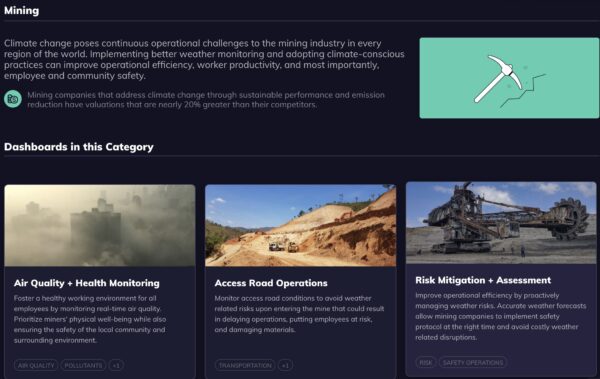
Tomorrow.io Mining Insights Template
Climate change increases the risk of more frequent and intense natural disasters that may damage mine, transportation, and energy infrastructure. This risk, in turn, disrupts construction and operations. With the rise in unpredictable, extreme weather events, the supply of critical inputs to mining processes, such as water and energy, will likely face more significant constraints.
More frequent droughts and floods could limit water supply to mining sites. Mines located in areas that are already facing stresses on these natural resources will face even more significant challenges:
- In Chile, 80% of copper production is already located in extremely high water-stressed and arid areas; by 2040, it will be 100%.
- In Russia, 40% of iron ore production is currently in high water-stressed areas, likely to move to extreme water stress by 2040.
- By 2040, 5% of current gold production will likely shift from low–medium water stress to medium-high, 7% of zinc production could move from medium-high to high water stress, and 6% of copper production could shift from high to extremely high water stress.
Even locations not known to be vulnerable to water shortages are suffering. In Germany, a potash miner was forced to close two locations because of severe water shortages in the summer of 2018, losing nearly $2 million a day per site.
As water shortages and stresses differ according to the area, mining companies need to analyze projections on individual sites rather than as a whole.
Rising temperatures can also cause fluctuations in energy demand and strain transmission and distribution facilities. If mining companies are forced to ration energy, this could decrease production and profits and increase commodity prices.
Warmer conditions and droughts will also reduce the water available for mining, processing, and refining activities. This reduction will raise the cost of pre-use and post-use water treatment.
In terms of transportation, severe weather events could also affect routes, from road to rail to port operations.
Community Impact
As much as high-impact weather affects mining operations and employee safety, we must also discuss the impact that severe weather conditions have on their local communities.
Mining brings jobs and stimulates local economies; new projects bring infrastructure developments. The industry can contribute to regional development and positively impact a community. However, mining activities have potentially harmful effects.
Mining operations can lead to environmental degradation, including water pollution, air pollution, soil erosion, and deforestation. Noise and dust can disrupt daily life and, without optimizing for blasts, can make life more difficult.
Improved forecasting tools that provide insights we can act on can help combat the impacts on local communities.
Building Climate Resilience: How to Proactively React to the Weather
Climate change scientists predict that weather events will continue to intensify while becoming more frequent in the coming years, especially if we don’t do more to reduce emissions. This intensifying will increase the risks for assets and employees.
Damage caused by climate-related disasters could lead to higher insurance premiums or make insurers unwilling to provide insurance/reinsurance. Also, future exploration may be restricted by expanded protections for biodiversity threatened by climate change and for forested areas that serve as carbon sinks.
The physical risks of climate change vary according to different locations and assets, and mines need to evaluate these risks accordingly. Mines must ensure they are operationally resilient when it comes to the effects of climate change. Steps to do this include introducing climate-proofing as a key part of their operational strategy.
Key questions mining organizations need to consider when planning and implementing practices include:
- How can we make climate change integral to our business decisions?
- How can we structure incentives and rewards to drive those decisions?
Forward-looking mining companies are already implementing more sustainable practices to adapt to climate change and reap the benefits. For example, Lithium Australia has developed a way to extract lithium using less energy-intensive and contaminating processes. Similarly, Northam Platinum has implemented a closed water circuit to ensure that 90 percent of the water used in its operations is recycled.
Mines should also know that preparing for and adapting to climate change presents business opportunities. Mining companies that address climate change through sustainable performance and emission reduction have valuations nearly 20% greater than their competitors.
Implementing Sustainable Mining Practices
Climate change is just one of the reasons that mines are looking for ways to become more sustainable. Reducing their direct and indirect carbon emissions footprint is also a critical goal. Mining is currently responsible for between four and seven percent of greenhouse gas emissions globally, and companies are facing pressure from governments, investors, and society to reduce these emissions.
Some of the solutions that mining companies can consider include:
- Change processes to improve energy efficiency
- Switch to lower carbon electricity source
- Electrify gas appliance
- Electrify trucks
- Use more fuel-efficient diesel engines
- Switch fuel from diesel to hydrogen
Replacing fossil fuels with renewable energy sources, such as wind or solar farms, would dramatically reduce carbon emissions, and with advances in technology, renewable energy is often cheaper.
For mines, moving to renewable sources of electricity is becoming an increasingly feasible possibility, but harnessing these sources depends on predicting and acting on the weather.
Wind, solar, and hydropower energy –– which are the primary renewable energy sources currently used–– are susceptible to fluctuating weather patterns. They rely on climate-related factors such as sunlight, wind speed, and water availability. This has implications for the reliability and performance of the energy system.
Mining companies also conduct pollution-creating activities that affect their relationship with nearby communities. Take blasting. If blasting is done under certain weather conditions, it can create a cloud of dust on top of the mine.
Mines need the data and technology to conduct a historical analysis that reveals the best times for blasting each season based on wind gusts to minimize their environmental impact. Once identified, historical data and real-time forecasts empower companies to plan blasting hours and predict weather anomalies.
Harnessing the Power of Weather Intelligence
If mines want to climate-proof their operations, they must leverage historical, current, and future scenarios to understand the implications of their operations. Access to this data allows them to create more diverse response strategies and better understand the impact of climate change and the weather.
Mining companies must be able to collect, analyze, and centralize data in a structured manner to assess their operations and impact holistically. Implementing better weather monitoring and adopting climate-conscious practices can improve operational efficiency, worker productivity, and, most importantly, employee and community safety.
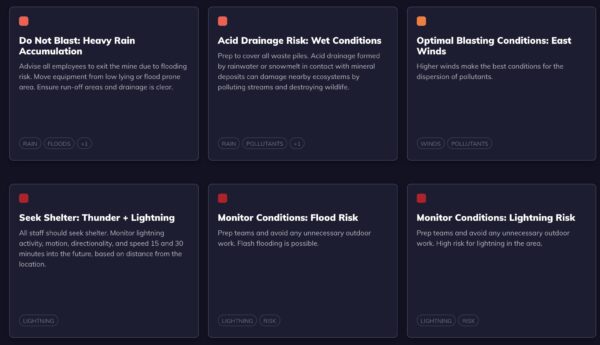
Tomorrow.io Mining Insights Template
By using weather intelligence to put this data into an operational context, mining companies can create strategies that take into account their geographical locations, mining techniques, and other commodities.
Weather intelligence allows these companies to proactively and effectively manage pending risks. With the right technology, they can create more effective plans that minimize and mitigate the disruption of adverse weather.
How Weather AI Revolutionizes Mining
Mines are in the middle of their digital revolution, adapting new tech and exploring new strategies to mitigate impending changes that could thwart efficient operation. By moving to a prevention-over-treatment model, advancements in weather technology are empowering mining operators with robust weather forecasting solutions.
Currently, most major mining organizations rely on a combination of re-packaged weather data from the National Weather Service mixed with reactionary weather-related decisions from project operators. These sources are great, but they fall short:
- No specificity: Traditional weather forecasts are broad; they may be for your region and not be accurate to specific mines.
- Insufficient lead time: Conventional forecasts might not warn enough about incoming high-impact weather conditions.
- Lack of focus on critical factors: Traditional forecasts might need to emphasize the factors that impact mining, such as wind direction, wind speed, and lighting risk.
Luckily, the tech we need to adapt to weather at scale is here! Tomorrow.io’s weather intelligence and weather AI solutions for mining are transformative for the industry.
Leveraging Weather Intelligence from Tomorrow.io
Tomorrow.io’s weather intelligence platform provides reliable forecasts to help mining teams better plan in advance and run more efficient operations. Weather intelligence can help mining companies make the most of conditions to improve sustainability, keep workers safe, and protect assets, rather than being at the mercy of the weather.
Using a combination of historical and real-time weather data, your team can generate actionable insights that enable you better to predict the weather’s impact on your business.
Tomorrow.io’s weather intelligence platform allows you to:
- Foster a healthy working environment for all employees by monitoring real-time air quality. Prioritize miners’ physical well-being while ensuring the local community’s safety and surrounding environment.
- Monitor access to road conditions to avoid weather-related risks upon entering the mine that could delay operations, put employees at risk, and damage materials.
- Improve operational efficiency by proactively managing weather risks. Accurate weather forecasts allow mining companies to implement safety protocols quickly and avoid costly weather-related disruptions.
- Minimize environmental disasters and address community concerns about ongoing mining operations. Schedule blasting times according to optimal weather conditions to effectively disperse pollutants and eliminate associated risks.
- Initiate weather-specific mining protocols and define effective techniques to prioritize employees’ health and safety during adverse weather conditions.
How Tomorrow.io’s Satellite Constellation Will Impact Mining
Tomorrow.io is positioned to continue improving weather forecasting for the mining industry and beyond. Space-based weather radar technology through our upcoming constellation is leading the way in our ability to prepare mines for hazardous weather events.
One of the limitations of traditional weather forecasting is that every outlet is re-packaging information from NASA, NOAA, and the NWS. These organizations are working off data from existing satellites in space.
Tomorrow.io is launching a first-of-its-kind commercial weather satellite constellation equipped with radars and microwave sounders to improve global weather forecasts. These satellites can detect precipitation with greater precision than traditional methods and provide more accurate rainfall intensity data. This constellation will provide mining operations with weather data for every location on Earth, anywhere, in real time.
Weather Intelligence for Weather Excellence
We can’t wait for the weather to dictate what we do; we must instead put tools in place to help us mitigate the impact of severe weather and high-impact conditions.
With Tomorrow.io’s weather and climate security platform, your mining organization can access the correct information at the right time, generate invaluable insights, and make more informed operational decisions.
With Tomorrow.io’s weather and climate security platform, your mining organization can access the right information at the right time, generate invaluable insights, and make more informed operational decisions.
